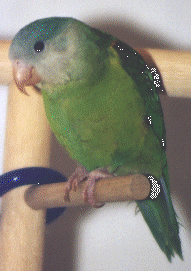
Special thanks to Beverly Marsh, who authored this page, and provided the above picture.

Special thanks to Beverly
Marsh, who authored this page, and provided the above picture.
One of several in the Brotogeris family, Grey-cheeked Parakeets (hereafter referred to
as grey cheeks)--also known as Pocket Parrots, Orange-winged Parakeets or Orange-flanked
Parakeets--get their name from their distinctive grey cheeks, chin, and forehead. Other
distinguishing features are a dusky blue crown and bright orange feathers on the underwing
coverts. Back, outer wing, and tail areas of their bodies are covered with iridescent
green feathers, similar to a male Eclectus, with a lighter green shade on their
underbellies. Until they are approximately 6 months old, grey cheeks have black or spotty,
black beaks. As they mature, their beaks become horn-colored.
Grey cheeks, with a wide variety of toys, can entertain themselves for hours; they
especially enjoy braided, fabric, rope perches. They are also very mischievous, very bold,
have an unending curiosity, and should be closely supervised when out of their cages.
Being very agile and proficient climbers, grey cheeks often get themselves into
interesting places and situations without supervision.
Note: The Grey Cheek is outlawed in Hawaii.
8 inches (20 cm & weigh 54-60 grams). They are a little larger than lovebirds in size.
Grey cheeks are not sexually dimorphic and need DNA (genetic) testing to determine their sex.
Originally from areas of northwestern Peru and western Ecuador.
Handfed babies have very sweet personalities and are extremely intelligent, curious, energetic, and very playful. With time and patience, they can be taught to do tricks, have a good capacity for talking, and are great mimickers as well.
Usually not very noisy when compared to larger birds like macaws, conures or cockatoos, but can become loud at times when over-excited, protecting their territory or when they think they are being ignored.
Prices usually range between $200 - $400.
|
Updated : 10/2022
(c) 1994-2022 Grant Yoshimori